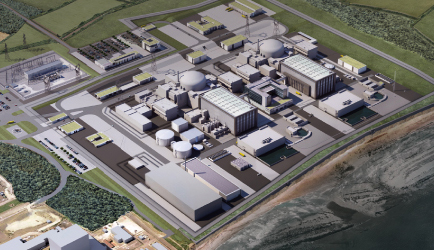I have blogged about the Hinkley Point C project in the U.K. several times. The price estimate of over thirty four billion dollars for two nuclear reactors makes it one of the most costly nuclear projects in history. The U.K. government decided that it was not going to fund nuclear projects several years ago which left the funding of the project in doubt. EDF, the French-owned firm that is slated to build the reactors made a tentative and controversial deal with a Chinese-owned company for about one third of the funds. There have been objections from labor unions, environmental groups, utilities and security forces in Britain to the project which I have detailed in previous posts. Today I am going to delve a bit deeper into the reason that the U.K. wants the project so badly.
Most of the nuclear reactors in the U.K. are advanced gas-cooled reactors (AGRs). About twenty percent of the electricity in the UK comes from eight nuclear power plants, seven of which are scheduled to be closed down by 2030. Coal power plants make up another twenty two percent of the power generation for the U.K. and they are scheduled to be closed permanently by 2025. This means that the U.K. could lose up to fifty percent of its power generation by 2030. The life of these nuclear and coal plants could be extended but this would be a temporary fix. And, extension of the coal plants would mean a setback for the reduction of carbon emissions.
This short fall of power might stimulate the development and adoption of alternative energy sources such as wind, solar and tidal generation. But the most likely way to make up the shortage will be with Combined Gas Cycle Turbines burning natural gas. These can be build relatively quickly but they are not low-carbon sources and they will contribute to climate change.
If Hinkley Point C is built, it will be able to supply about seven percent of the needed electricity. However, part of the deal is a guarantee by the British government to pay about twice the current price for electricity for the life of the plant. If Hinkley has to compete with gas-fired power plants and alternative energy sources that can supply cheaper electricity, then the rate payers will be locked into long term contracts at an inflated price.
There are other nuclear projects in various stages in Britain with companies such as Hitachi and Toshiba involved. These projects may continue even if Hinkley Point C is cancelled but the odds are that they will not be unaffected. Investors might pull out because of fear that Britain is no longer able to launch and complete large energy projects.
The U.K., France and China are seriously committed to the Hinkley Point C project. They have a huge political stake in the successful completion of the project. Beyond power generation, there is the goal of convincing the public that nuclear power is safe and economical. The failure of the Hinkley Point C project would deal a serious blow to public confidence in such projects. On the other hand, if the project is started but not finished, it would also be a serious setback. And, if the project is completed but supplies electricity at a very uncompetitive price, that will not help the future of nuclear power generation either.
Artist's concept of the Hinkley Point C nuclear power plant:
